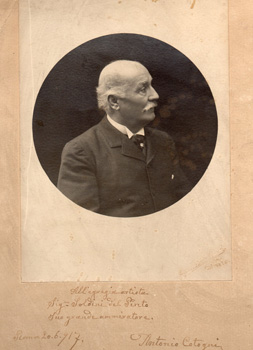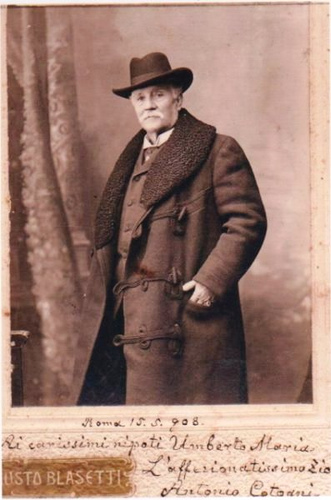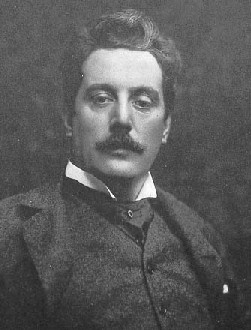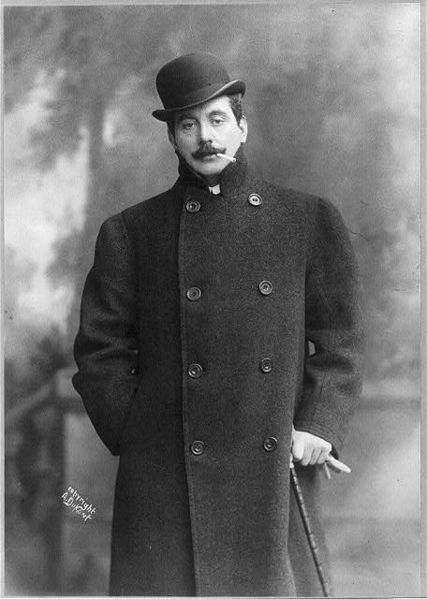<Back to Index>
- Baritone Antonio Cotogni, 1831
- Composer Giacomo Antonio Domenico Michele Secondo Maria Puccini, 1858
PAGE SPONSOR


Antonio Cotogni (August 1, 1831, Rome - October 15, 1918, Rome) was an Italian baritone of the first magnitude. Regarded internationally as being one of the greatest male opera singers of the 19th century, he was particularly admired by the composer Giuseppe Verdi. Cotogni forged an important second career as a singing teacher after his retirement from the stage in 1898.
A native of Rome, Cotogni was of humble origins. He studied first at the Hospice of San Michele, and afterwards under Faldi, Capocci, Mustafà and Aldega, gaining his first success in the Oratory of the Filippini in the Chiesa Nuova. He also studied with Fontemaggi. He made his debut at Rome's Teatro Metastasio, as Belcore in L'elisir d'amore, in 1852. He sang successfully on the Italian operatic circuit before reaching La Scala, Milan, in 1860. During the ensuing decades, he also appeared at the leading opera houses in Madrid, Lisbon, Paris, London, Moscow and St Petersburg. He became enormously popular with London audiences, performing at the Royal Opera House, Covent Garden, from 1867 to 1889. He sang at St Petersburg in 26 successive seasons.
Cotogni was an especial favorite of Verdi's, who praised him for the beauty, warmth and strength of his voice, as well as for the emotional intensity which he brought to his musical interpretations. He sang most of the major Verdi baritone roles and took part in the first Italian staging of Don Carlo, in Bologna in 1867, under the supervision of the composer. But his operatic triumphs were not confined to Verdi's compositions. He was also a brilliant exponent of the elegant but technically demanding bel canto music of Gaetano Donizetti and Vincenzo Bellini.
Cotogni retired from the operatic stage in February 1898, having sung an estimated 127 (some sources say 157) roles. They ranged from the major parts in Mozart's Italian operas through to what were, from Cotogni's perspective, cutting - edge modern parts in such verismo works as Pagliacci and Manon Lescaut. His interpretations of the lead baritone characters in Un ballo in maschera, Ernani, Linda di Chamounix, Faust, L'elisir d'amore and Il barbiere di Siviglia were especially admired. Cotogni's final appearance was as Don Pasquale in Donizetti's comic opera of the same name.
In retirement, Cotogni became one of the most celebrated vocal teachers in history. He taught briefly in St Petersburg (at the invitation of Anton Rubinstein) but he had to abandon this post in consequence of a serious illness, subsequently taking up an appointment in 1902 as a professor at the Accademia di Santa Cecilia in Rome. Here he founded what became known as the "Roman School of Singing". Among those who studied under him during this period were the world famous tenors Beniamino Gigli and Giacomo Lauri - Volpi and the leading baritones Mario Basiola, Benvenuto Franci and Mariano Stabile. Two other star singers, Jean de Reszke and Mattia Battistini, consulted him as well.
Cotogni ranks with his contemporaries Francesco Graziani, Jean - Baptiste Faure and Sir Charles Santley as the foremost baritone of his star - studded generation. He "had a very brief and scarcely revealing relationship with the gramophone; at the age of 77 ... with the tenor Francesco Marconi, he recorded [the] duet 'I Mulatieri'", writes Michael Scott. "Not surprisingly Marconi gets the better of it. Still, however difficult it is to make out Cotogni's contribution, it is all we have left of a singer who for over 40 years dominated the stages in London, Madrid and Lisbon, St Petersburg and Moscow and throughout Italy."
Cotogni died of old age in Rome less than a month prior
to the 1918 armistice which ended World War I.


Giacomo Antonio Domenico Michele Secondo Maria Puccini (22 December 1858 – 29 November 1924) was an Italian composer whose operas, including La bohème, Tosca, Madama Butterfly, and Turandot, are among the most frequently performed in the standard repertoire. Some of his arias, such as "O mio babbino caro" from Gianni Schicchi, "Che gelida manina" from La bohème, and "Nessun dorma" from Turandot, have become part of popular culture.
Described by Encyclopædia Britannica
Online as "one of the greatest exponents of
operatic realism",
he is regarded as one of the last major Italian opera
composers.
His repertoire is essentially rooted in verismo,
or a post - Romantic operatic tradition and
literary style. Whilst his work is essentially based on
traditional late 19th century Italian opera, his music
shows some influences from then - contemporary composers
and
movements such as Igor Stravinsky and Impressionism.
Common themes within his operas include the important
role, yet usually tragic end, of his heroines, as
well as love; furthermore, there is a strong presence of exoticism in his operas,
with several being set in faraway locations.
Puccini was born in Lucca in Tuscany, into a family with five generations of musical history behind them, including composer Domenico Puccini. His father died when Giacomo was five years old, and he was sent to study with his uncle Fortunato Magi, who considered him to be a poor and undisciplined student. Magi may have been prejudiced against his nephew because his contract as choir master stipulated that he would hand over the position to Puccini "as soon as the said Signore Giacomo be old enough to discharge such duties." Puccini never took the position of church organist and choir master in Lucca. When he was 17, he saw a performance of Verdi's Aida and became inspired to be an opera composer. He and his brother, Michele, walked 18.5 mi (30 km) to see the performance in Pisa.
In 1880, with the help of a relative and a grant, Puccini enrolled in the Milan Conservatory to study composition with Stefano Ronchetti - Monteviti, Amilcare Ponchielli, and Antonio Bazzini. In the same year, at the age of 21, he composed the Messa, which marks the culmination of his family's long association with church music in his native Lucca. Although Puccini himself correctly titled the work a Messa, referring to a setting of the Ordinary of the Catholic Mass, today the work is popularly known as his Messa di Gloria, a name that technically refers to a setting of only the first two prayers of the Ordinary, the Kyrie and the Gloria, while omitting the Credo, the Sanctus, and the Agnus Dei.
The work anticipates Puccini's career as an operatic composer by offering glimpses of the dramatic power that he would soon bring forth onto the stage; the powerful "arias" for tenor and bass soloists are certainly more operatic than is usual in church music and, in its orchestration and dramatic power, the Messa compares interestingly with Verdi's Requiem.
While studying at the Conservatory, Puccini obtained a libretto from Ferdinando Fontana and entered a competition for a one act opera in 1882. Although he did not win, Le Villi was later staged in 1884 at the Teatro Dal Verme and it caught the attention of Giulio Ricordi, head of G. Ricordi & Co. music publishers, who commissioned a second opera, Edgar, in 1889. Edgar failed: it was a bad story and Fontana's libretto was poor. This may have had an effect on Puccini's thinking because when he began his next opera, Manon Lescaut, he announced that he would write his own libretto so that "no fool of a librettist" could spoil it. Ricordi persuaded him to accept Leoncavallo as his librettist, but Puccini soon asked Ricordi to remove him from the project. Four other librettists were then involved with the opera, due mainly to Puccini constantly changing his mind about the structure of the piece. It was almost by accident that the final two, Illica and Giacosa, came together to complete the opera. They remained with Puccini for his next three operas and probably his greatest successes: La bohème, Tosca and Madama Butterfly.
It may well have been the failure of Edgar that made Puccini so apt to change his mind. Edgar nearly cost him his career. Puccini had eloped with the married Elvira Gemignani and Ricordi's associates were willing to turn a blind eye to his life style as long as he was successful. When Edgar failed, they suggested to Ricordi that he should drop Puccini, but Ricordi said that he would stay with him and made him an allowance from his own pocket until his next opera. Manon Lescaut was a great success and Puccini went on to become the leading operatic composer of his day.
From 1891 onwards, Puccini spent most of his time at Torre del Lago, a small
community about fifteen miles from Lucca situated between
the Ligurian Sea and Lake
Massaciuccoli, just south of Viareggio. While renting a house
there, he spent time hunting, but regularly visited Lucca.
By 1900, he had acquired land and built a villa on the lake, now known as the "Villa Museo Puccini." He lived there until 1921, when pollution produced by peat works on the lake forced him to move to Viareggio, a few kilometers north. After his death, a mausoleum was created in the Villa Puccini and the composer is buried there in the chapel, along with his wife and son who died later.
The Villa Museo Puccini is presently owned by his
granddaughter, Simonetta Puccini, and is open to the
public.
- Manon Lescaut (1893), his third opera, was his first great success. It launched his remarkable relationship with the librettists Luigi Illica and Giuseppe Giacosa, who collaborated with him on his next three operas, which became his three most famous and most performed operas. These were:
- La bohème (1896) is considered one of his best works as well as one of the most romantic operas ever composed. It is together with Tosca one of today's most popular operas.
- Tosca (1900) was arguably Puccini's first foray into verismo, the realistic depiction of many facets of real life including violence. The opera is generally considered of major importance in the history of opera because of its many significant features.
- Madama Butterfly (1904) was initially greeted with great hostility (mostly organized by his rivals) but, after some reworking, became another of his most successful operas.
After 1904, compositions were less frequent. Following his passion for driving fast cars, Puccini was nearly killed in a major accident in 1903. In 1906 Giacosa died and, in 1909, there was scandal after Puccini's wife, Elvira, falsely accused their maid Doria Manfredi of having an affair with Puccini. The maid then committed suicide. Elvira was successfully sued by the Manfredis, and Giacomo had to pay damages. Finally, in 1912, the death of Giulio Ricordi, Puccini's editor and publisher, ended a productive period of his career.
However, Puccini completed La fanciulla del West in 1910 and finished the score of La rondine in 1916.
In 1918, Il trittico premiered in
New York. This work is composed of three one - act operas: a
horrific episode (Il tabarro), in the style
of the Parisian Grand Guignol, a sentimental tragedy (Suor Angelica), and a comedy (Gianni Schicchi). Of
the three, Gianni Schicchi has remained the most
popular, containing the popular aria "O mio babbino caro".
A chain smoker of Toscano cigars and cigarettes, Puccini began to complain of chronic sore throats towards the end of 1923. A diagnosis of throat cancer led his doctors to recommend a new and experimental radiation therapy treatment, which was being offered in Brussels. Puccini and his wife never knew how serious the cancer was, as the news was only revealed to his son.
Puccini died there on 29 November 1924, from complications after the treatment; uncontrolled bleeding led to a heart attack the day after surgery. News of his death reached Rome during a performance of La bohème. The opera was immediately stopped, and the orchestra played Chopin's Funeral March for the stunned audience. He was buried in Milan, in Toscanini's family tomb, but that was always intended as a temporary measure. In 1926 his son arranged for the transfer of his father's remains to a specially created chapel inside the Puccini villa at Torre del Lago.
Turandot, his final opera, was left unfinished, and the last two scenes were completed by Franco Alfano based on the composer's sketches. Some dispute whether Alfano followed the sketches or not, since the sketches were said to be indecipherable, but he is believed to have done so, since, together with the autographs, he was given (still existing) transcriptions from Guido Zuccoli who was accustomed to interpreting Puccini's handiwork.
When Arturo Toscanini conducted the premiere performance in April 1926 (in front of a sold out crowd, with every prominent Italian except for Benito Mussolini in attendance), he chose not to perform Alfano's portion of the score. The performance reached the point where Puccini had completed the score, at which time Toscanini stopped the orchestra. The conductor turned to the audience and said: "Here the opera finishes, because at this point the Maestro died." (Some record that he said, more poetically, "Here the Maestro laid down his pen.") (Some record that then Toscanini picked up the baton, turned to the audience, and announced, "But his disciples finished his work." At which time the opera closed to thunderous applause.)
Toscanini's laying down the baton has been misinterpreted by some journalists as a gesture of disapproval of Alfano's contribution. In 2009 William Hartson in the Daily Express told his readers with great authority that "Toscanini never conducted Turandot again." In fact, he conducted it again on the two following nights – including Alfano's ending – a total of three performances.
Toscanini edited Alfano's suggested completion ('Alfano I'), to produce a version now known as 'Alfano II', and this is the version usually used in performance. However, some musicians consider Alfano I to be a more dramatically complete version.
In 2002, an official new ending was composed by Luciano Berio from original
sketches, but this finale has, to date, been performed only infrequently.
Unlike Verdi and Wagner, Puccini did not appear to be active in the politics of his day. However, Mussolini, Fascist dictator of Italy at the time, claimed that Puccini applied for admission to the National Fascist Party. While it has been proven that Puccini was indeed among the early supporters of the Fascist party at the time of the election campaign of 1919 (in which the Fascist candidates were utterly defeated, earning a meager 4,000 votes), there appear to be no records or proof of any application given to the party by Puccini.
This notwithstanding, Fascist propaganda appropriated Puccini's figure, and one of the most widely played marches during Fascist street parades and public ceremonies was the "Inno a Roma" (Hymn to Rome), composed in 1919 by Puccini to lyrics by Fausto Salvatori, based on these verses from Horace's Carmen saeculare:
Alme Sol, curru nitido diem qui / Promis et celas
alius que et idem / Nasceris, possis nihil urbe Roma /
Visere maius. (O Sun, that unchanged, yet ever new,
/ Lead'st out the day and bring'st it home, / May nothing
be present to thy view / Greater than Rome!)
Puccini clearly occupies a place in the popular tradition of Verdi, his style of orchestration showing the strong influence of Richard Wagner, matching specific orchestral configurations and timbres to different dramatic moments. Whilst at its heart, Puccini's music is based on the traditional diatonic melodies of Italian opera in the time, influences can be heard of "contemporary developments" including the music of Igor Stravinsky and Impressionism. He has been described by Encyclopædia Britannica Online as "In many ways a typical fin de siècle artist".
The structures of Puccini's works are also noteworthy. While it is to an extent possible to divide his operas into arias or numbers (like Verdi's), his scores are generally through - composed presenting a very strong sense of continuous flow and connectivity, perhaps another sign of Wagner's influence. Like Wagner, Puccini used leitmotifs to connote characters and sentiments (or combinations thereof). This is most apparent in Tosca, where the three chords which signal the beginning of the opera are used throughout to announce Scarpia; the descending brass motive (Vivacissimo con violenza) is connected to the repressive regime which ruled Rome at the setting of the opera and most clearly to Angelotti, one of the regime's victims; the harp arpeggio figure which appears at Tosca's entrance and the aria Vissi d'arte symbolizing Tosca's religious fervor; the clarinet ascending - descending scale indicating Mario's suffering and his doomed love for Tosca. Several motifs are also linked to Mimi and the bohemians in La bohème and to Cio-Cio San's eventual suicide in Butterfly. Unlike Wagner, Puccini's motifs are in some cases static; they are intended to direct the audience's attention to a particular idea. However, throughout his operas, for example the love motifs in La bohème, there are examples of his melodies developing to signal a change in a character.
Another distinctive quality in Puccini's works is the use of the voice in the style of speech i.e. canto parlando; characters sing short phrases one after another as if they were in conversation. Puccini is also celebrated for his melodic gift and many of his melodies are both memorable and enduringly popular. At their simplest these melodies are made of sequences from the scale, e.g. Quando me'n vo' (Musetta's Waltz) from La bohème and E lucevan le stelle from Act III of Tosca.
Puccini's operas additionally included several themes; one of the most common include that of heroines, who are "devoted body and soul to their lovers"; a tragic end often waits for them due to their guilt. Examples of leading women who die in his operas include Cio-Cio San in Madama Butterfly, Mimì in La bohème or Tosca in Tosca. According to Encyclopædia Britannica Online, with such themes Puccini "combines compassion and pity for his heroines with a strong streak of sadism". Additionally, unusually for operas written by Italian composers up until that time, many of Puccini’s operas are set outside Italy — in exotic places such as Japan (Madama Butterfly), gold - mining country in California (La fanciulla del West), Paris and the Riviera (La rondine), and China (Turandot). A composer within the realm of verismo, this can be seen through his operas, where the usage of common people in everyday, "familiar" situations (once seen unfit for artistic portrayal) are included, such as in La bohème.
Pulitzer Prize winning music critic Lloyd Schwartz summarized Puccini thus: "Is it possible for a work of art to seem both completely sincere in its intentions and at the same time counterfeit and manipulative? Puccini built a major career on these contradictions. But people care about him, even admire him, because he did it both so shamelessly and so skillfully. How can you complain about a composer whose music is so relentlessly memorable, even — maybe especially — at its most saccharine?"
In his work on Puccini, noted Verdi scholar Julian Budden describes
Puccini as a gifted and original composer, noting the
vibrant innovation hidden in the popularity of works such
as "Che gelida manina". He describes the aria in musical
terms (the signature embedded in the harmony for example),
and points out that its structure was rather unheard of at
the time, having three distinct musical paragraphs that
nonetheless form a complete and coherent whole. This
gumption in musical experimentation was the essence of
Puccini's style, as evidenced in his diverse settings and
use of the motif to express ideas beyond those in the
story and text.
Founded in 1996 in Lucca, the Centro Studi Giacomo Puccini embraces a wide range of approaches to the study of Puccini's work.
In the USA, the American Center for Puccini Studies specializes in the presentation of unusual performing editions of composer's works and introduces many neglected or unknown Puccini pieces to the music loving public. It was founded in 2004 by leading Puccini artist and scholar, Dr. Harry Dunstan.